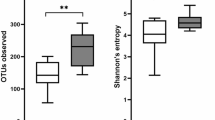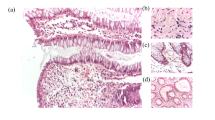Abstract
The pathogenesis of ulcerative colitis (UC) remains unknown. It is thought to be due to an abnormal and uncontrolled immune response to normally occurring constituents of the intestine. Microbial agents appear to be involved in the pathogenesis and intestinal bacteria seem to be an important factor in the development and chronicity. The aim of this study was to investigate the colonic microbiota of a patient with UC. The colonic tissues were taken during surgery from a 12-year-old girl suffering from UC. The microbiota on the colonic samples was studied by cloning and sequencing of amplified 16S rRNA genes. Compared with healthy subjects, alteration of the dominant bacterial group was observed in the UC patient. We found a high incidence of Enterobacteriaceae, Bacteroides fragilis, and the single phylotype of the Faecalibacterium prausnitzii-like “Butyrate-producing bacterium” L2-6. Furthermore, there was a substantial presence of Pseudomonas aeruginosa in the present case of UC. The high proportion of adverse proinflammatory species is striking in the present case compared with more normal situations. Even if those bacteria are not the cause of the UC, they most probably enhance the symptoms of the disease.

Similar content being viewed by others
References
Shivananda S, Lennard-Jones J, Logan R, Fear N, Price A, Carpenter L, van Blauthenstein M (1996) Incidence of inflammatory bowel disease across Europe: is there a difference between north and south? Results of the European collaborative study on inflammatory bowel disease (EC-IBD). Gut 39:690–697
Ardizzone S, Bollani S, Manzionna G, Bianchi Porro G (1999) Inflammatory bowel disease approaching the 3rd millennium: pathogenesis and therapeutic implications. Eur J Gastroenterol Hepatol 11:17–32
Campieri M, Gionchetti P (2001) Bacteria as the cause of ulcerative colitis. Gut 48:132–135
Schultz M, Sartor RB (2000) Probiotics and inflammatory bowel diseases. Am J Gastroenterol 95:S19–S21
Bruzzese, E, Canani RB, De Marco G, Guarino A (2004) Microflora in inflammatory bowel diseases: a pediatric perspective. J Clin Gastroenterol 38:S91–S93
Roediger WE, Duncan A, Kapaniris O, Millard S (1993) Reducing sulphur compounds of the colon impair colonocyte nutrition: implications for ulcerative colitis. Gastroenterology 104: 802– 809
Schultsz C, Van Den Berg FM, Ten Kate FW, Tytgat GNJ, Dankert J (1999) The intestinal mucus layer from patients with inflammatory bowel disease harbours high numbers of bacteria compared with controls. Gastroenterology 117:1089–1097
Sartor RB (2004) Therapeutic manipulation of the enteric microflora in inflammatory bowel diseases: antibiotics, probiotics, and prebiotics. Gastroenterology 126:1620–1633
Poxton IR, Brown R, Sawyerr A, Ferguson A (1997) Mucosa-associated bacterial flora of the human colon. J Med Microbiol 46:85–91
Giaffer MH, Holdsworth CD, Duerden BI (1992) Virulence properties of Escherichia coli strains isolated from patients with inflammatory bowel disease. Gut 33:646–650
Darfeuille-Michaud A, Neut C, Barnich N, Lederman E, Di Martino P, Desreumaux P, Gambiez L, Joly B, Cortot A, Colombel JF (1998) Presence of adherent Escherichia coli strains in ileal mucosa of patient with Crohn's disease. Gastroenterology 115:1405– 1413
Balish E, Warner T (2002) Enterococcus faecalis induces inflammatory bowel disease in interleukin-10 knockout mice. Am J Pathol 160:2253–2255
Hugenholtz P, Goebel BM, Pace NR (1998) Impact of culture-independent studies on the emerging phylogenetic view of bacterial diversity. J Bacteriol 180:4765–4774
Suau A, Bonnet R, Sutren M, Godon JJ, Gibson GR, Collins MD, Doré J (1999) Direct analysis of genes encoding 16S rRNA from complex communities reveals many novel molecular species within the human gut. Appl Environ Microbiol 65:4799–4807
Hold GL, Pryde SE, Russell VJ, Furrie E, Flint, HJ (2002) Assessment of microbial diversity in human colonic samples by 16S rDNA sequence analysis. FEMS Microbiol Ecol 39:33–39
Wang X, Heazlewood SP, Krause DO, Florin TH (2003) Molecular characterization of microbial species that colonize human ileal and colonic mucosa by using 16S rDNA sequence analysis. J Appl Microbiol 95:508–520
Wang M, Ahrné S, Jeppsson B, Molin G (2005) Comparison of bacterial diversity along the human intestinal tract by direct cloning and sequencing of 16S rRNA genes. FEMS Microbiol Ecol 54:219–231
Hultman T, Bergh S, Moks T, Uhlén M (1991) Bidirectional solid-phase sequencing of in vitro-amplified plasmid DNA. BioTechniques 10:84–93
Altschul SF, Gish W, Miller W, Meyers EW, Lipman DJ (1990) Basic local alignment search tool. J Mol Biol 215:403–410
Thompson JD, Gibson TJ, Plewniak F, Jeanmougin F, Higgins DG (1997) The CLUSTAL_X Windows interface: flexible strategies for multiple sequence alignment aided by quality analysis tools. Nucleic Acids Res 25:4876–4882
Hall TA (1999) BioEdit: a user-friendly biological sequence alignment editor and analysis program for Window 95/98/NT. Nucleic Acids Symp Ser 41:95–98
Saitou N, Nei M (1987) The neighbor-joining method: a new method for reconstructing phylogenetic trees. Mol Biol Evol 4:406–425
Page RDM (1996) TREEVIEW: an application to display phylogenetic trees on personal computers. Comput Applic Biosci 12:357–358
Cole JR, Chai B, Marsh TL, Farris RJ, Wang Q, Kulam SA, Chandra S, McGarrell DM, Schmidt TM, Garrity GM, Tiedje JM (2003) The Ribosomal Database Project (RDP-II): previewing a new autoaligner that allows regular updates and the new prokaryotic taxonomy. Nucleic Acids Res 31:442–443
Collins MD, Lawson PA, Willems A, Cordoba JJ, Fernandez−Garayzabal J, Garcia P, Cai J, Hippe H, Farrow JA (1994) The phylogeny of genus Clostridium: proposal of five new genera and eleven new species combinations. Int J Syst Bacteriol 44:812–826
Barcenilla A, Pryde SE, Martin JC, Duncan SH, Stewart CS, Henderson C, Flint HJ (2000) Phylogenetic relationships of butyrate-producing bacteria from the human gut. Appl Environ Microbiol 66:1654–1661
Sartor RB, Rath HC, Sellon RK (1996) Microbial factors in chronic intestinal inflammation. Curr Opin Gastroenterol 12:327–333
Rutgeerts P, Geboes K, Peeters M, Hiele M, Penninckx F, Aerts R, Kerremans R, Vantrappen G (1991) Effect of faecal stream diversion on recurrence of Crohn's disease in the neoterminal ileum. Lancet 338:771–774
Sellon RK, Tonkonogy S, Schultz M, Dieleman LA, Grenther W, Balish E, Rennick DM, Sartor RB (1998) Resident enteric bacteria are necessary for development of spontaneous colitis and immune system activation in interleukin-10-deficient mice. Infect Immun 66:5224–5231
Ehrhardt RO, Lúdvíksson BR, Gray B, Neurath M, Strober W (1997) Induction and prevention of colonic inflammation in IL-2-deficient mice. J Immunol 158:566–573
Rossolini GM, Mantengoli E (2005) Treatment and control of severe infections caused by multiresistant Pseudomonas aeruginosa. Clin Microbiol Infect 11(Suppl 4):17–32
Navon-Venezia S, Ben-Ami R, Carmeli Y (2005) Update on Pseudomonas aeruginosa and Acinetobacter baumannii infections in the healthcare setting. Curr Opin Infect Dis 18:306– 313
Burke DA, Axon ATR (1987) Ulcerative colitis and Escherichia coli with adhesive properties. J Clin Pathol 40:782–786
Burke DA, Axon ATR (1988) Adhesive E. coli in inflammatory bowel disease and infected diarrhoea. BMJ 297:102–104
Schultsz C, Moussa M, van Ketel R, Tytgat GNJ, Dankert J (1997) Frequency of pathogenic and enteroadherent Escherichia coli in patients with inflammatory bowel disease and controls. J Clin Pathol 50:573–579
Walmsley RS, Anthony A, Sim R, Pounder RE, Wakefield AJ (1998) Absence of Escherichia coli, Listeria monocytogenes, and Klebsiella pneumoniae antigens within inflammatory bowel disease tissues. J Clin Pathol 51:657–661
Holdeman LV, Good IJ, Moore WEC (1976) Human fecal flora: variation in bacterial composition within individuals and a possible effect of emotional stress. Appl Environ Microbiol 31:359– 375
Rath HC, Wilson KH, Sartor RB (1999) Differential induction of colitis and gastritis in HLA-B27 transgenic rats selectively colonized with Bacteroides vulgatus or Escherichia coli. Infect Immun 67:2969–2974
Rath HC, Herfarth HH, Ikeda JS, Grenther WB, Hamm Jr TE, Balish E, Taurog JD, Hammer RE, Wilson KH, Sartor RB (1996) Normal luminal bacteria, especially Bacteroides species, mediate chronic colitis, gastritis, and arthritis in HLA-B27/human β2 microglobulin transgenic rats. J Clin Invest 98:945–953
Matsuda H, Fujiyama Y, Andoh A, Ushijima T, Kajinami T, Bamba T (2000) Characterization of antibody responses against rectal mucosa-associated bacterial flora in patients with ulcerative colitis. J Gastroenterol Hepatol 15:61–68
Polk FB, Kasper DL (1996) Bacteroides fragilis subspecies in clinical isolates. Ann Intern Med 86:569–571
Redondo MC, Arbo MD, Grindlinger J, Snydman DR (1995) Attributable mortality of bacteremia associated with the Bacteroides fragilis group. Clin Infect Dis 20:1492–1496
Sanfilippo L, Li CKF, Seth R, Balwin TJ, Menozzi MG, Mahida YR (2000) Bacteroides fragilis enterotoxin induces the expression of IL-8 and transforming growth factor-beta (TFG-β) by human colonic epithelial cells. Clin Exp Immunol 119:456–463
Kim JM, Oh YK, Kim YJ, Oh HB, Cho YJ (2001) Polarized secretion of CXC chemokines by human intestinal epithelial cells in response to Bacteroides fragilis enterotoxin: NF-κB plays a major role in the regulation of IL-8 expression. Clin Exp Immunol 123:421–427
Prindiville TP, Sheikh RA, Cohen SH, Tang YJ, Cantrell MC, Silva Jr J (2000) Bacteroides fragilis enterotoxin gene sequences in patients with inflammatory bowel disease. Emerg Infect Dis 6:171–174
Wu S, Morin PJ, Maouyo D, Sears CL (2003) Bacteroides fragilis enterotoxin induces c-Myc expression and cellular proliferation. Gastroenterology 124:392–400
Poxton IR, Edmond DM (1995) Biological activity of Bacteroides lipopolysaccharide−reappraisal. Clin Infect Dis 20:S149–S153
Cummings JH (1981) Short chain fatty acids in the human colon. Gut 22:763–779
Wächtershäuser A, Stein J (2000) Rationale for the luminal provision of butyrate in intestine disease. Eur J Nutr 39:164–171
Hold GL, Schwiertz A, Aminov RI, Blaut M, Flint HJ (2003) Oligonucleotide probes that detect quantitatively significant groups of butyrate-producing bacteria in human feces. Appl Environ Microbiol 69:4320–4324
Roediger WE (1980) The colonic epthelium in ulcerative colitis: an energy-deficiency disease? Lancet 2:712–715
Scheppach W, Sommer H, Kirchner T, Paganelli GM, Bartram P, Christl S, Richter F, Dusel G, Kasper H (1992) Effect of butyrate enemas on the colonic mucosa in distal ulcerative colitis. Gastroenterology 103:51–56
Schauber J, Bark T, Jaramillo E, Katouli M, Sandstedt B, Svenberg T (2000) Local short-chain fatty acids supplementation without beneficial effect on inflammation in excluded rectum. Scan J Gastroenterol 35:184–198
Steinhart AH, Hiruki T, Brzezinski A, Paker JP (1996) Treatment of left-sided ulcerative colitis with butyrate enemas: a controlled trail. Aliment Pharmacol Ther 10:729–736
Fusunyan RD, Quinn JJ, Ohno Y, MacDermott RP, Sanderson IR (1998) Butyrate enhances interleukin (IL)-8 secretion by intestinal epithelial cells in response to IL-1β and lipopolysaccharide. Pediatr Res 43:84–90
Keshavarzian A, Fusunyan RD, Jacyno M, Winship D, MacDermott RP, Sanderson IR (1999) Increased interleukin-8 (IL-8) in rectal dialysate from patients with ulcerative colitis: evidence for a biological role for IL-8 in inflammation of the colon. Am J Gastroenterol 94:704–712
Daig R, Andus T, Aschenbrenner E, Falk W, Scholmerich J, Gross V (1996) Increased interleukin 8 expression in the colon mucosa of patients with inflammatory bowel disease. Gut 38:216–222
Mylonaki M, Langmead L, Pantes A, Johnson F, Rampton DS (2004) Enteric infection in relapse of inflammatory bowel disease: importance of microbiological examination of stool. Eur J Gastroenterol Hepatol 16:775–778
Acknowledgment
The authors thank Bertil Pettersson at the Department of Biotechnology, Royal Institute of Technology, Sweden, for sequencing bacterial clones.
Author information
Authors and Affiliations
Corresponding author
Rights and permissions
About this article
Cite this article
Wang, M., Molin, G., Ahrné, S. et al. High Proportions of Proinflammatory Bacteria on the Colonic Mucosa in a Young Patient with Ulcerative Colitis as Revealed by Cloning and Sequencing of 16S rRNA Genes. Dig Dis Sci 52, 620–627 (2007). https://doi.org/10.1007/s10620-006-9461-1
Received:
Accepted:
Published:
Issue Date:
DOI: https://doi.org/10.1007/s10620-006-9461-1




